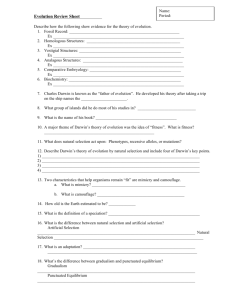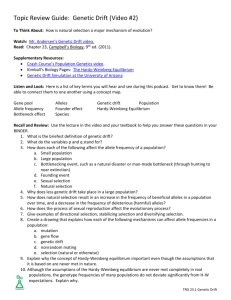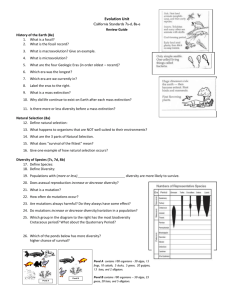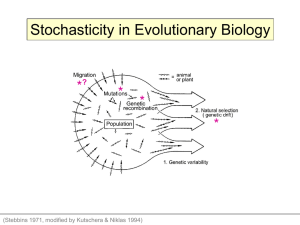Cultural Drift: A Primary Process of Culture Change Author(s): Henry
advertisement
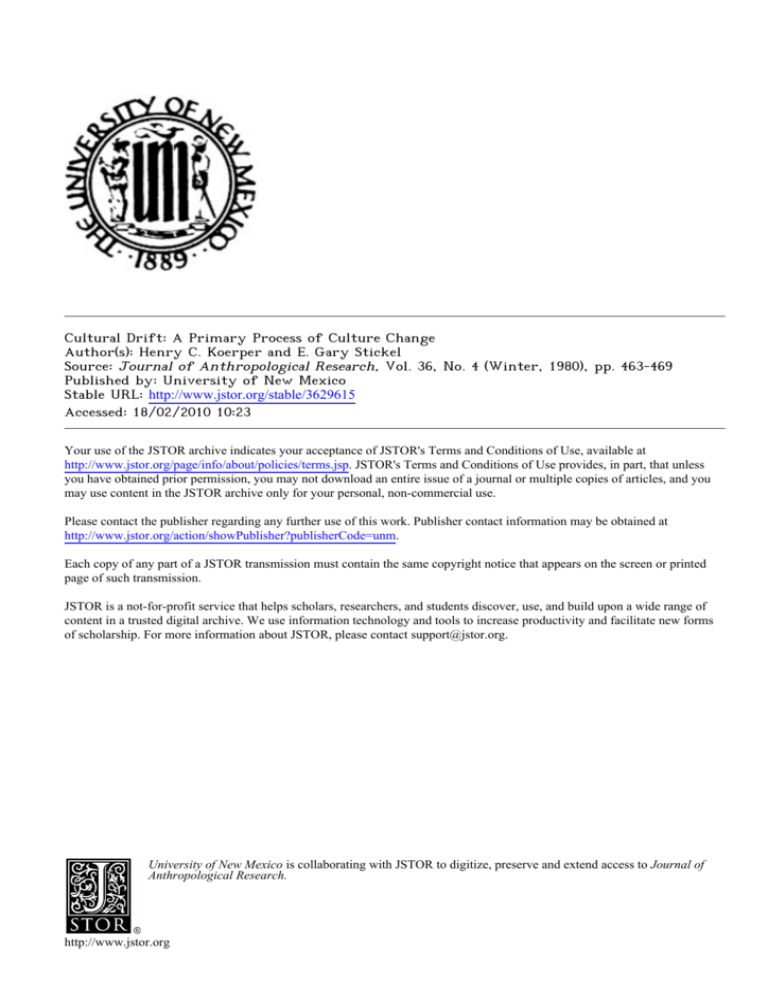
Cultural Drift: A Primary Process of Culture Change Author(s): Henry C. Koerper and E. Gary Stickel Source: Journal of Anthropological Research, Vol. 36, No. 4 (Winter, 1980), pp. 463-469 Published by: University of New Mexico Stable URL: http://www.jstor.org/stable/3629615 Accessed: 18/02/2010 10:23 Your use of the JSTOR archive indicates your acceptance of JSTOR's Terms and Conditions of Use, available at http://www.jstor.org/page/info/about/policies/terms.jsp. JSTOR's Terms and Conditions of Use provides, in part, that unless you have obtained prior permission, you may not download an entire issue of a journal or multiple copies of articles, and you may use content in the JSTOR archive only for your personal, non-commercial use. Please contact the publisher regarding any further use of this work. Publisher contact information may be obtained at http://www.jstor.org/action/showPublisher?publisherCode=unm. Each copy of any part of a JSTOR transmission must contain the same copyright notice that appears on the screen or printed page of such transmission. JSTOR is a not-for-profit service that helps scholars, researchers, and students discover, use, and build upon a wide range of content in a trusted digital archive. We use information technology and tools to increase productivity and facilitate new forms of scholarship. For more information about JSTOR, please contact support@jstor.org. University of New Mexico is collaborating with JSTOR to digitize, preserve and extend access to Journal of Anthropological Research. http://www.jstor.org CULTURAL DRIFT: A PRIMARY PROCESS OF CULTURE CHANGE Henry C. Koerper Department of Anthropology, University of California at Riverside, Riverside, CA E. Gary Stickel Environmental Research Archaeologists, Los Angeles, CA The term "drift" is often conceptualized as a primary process of culture change. Whether or not perceived as a cultural analog of biology's genetic drift or similar sampling phenomena, "drift" is generally vaguely definedand/or used nonproductively. This incorrect usage often masks the proper processes, which might more clearly elucidate particular change phenomena. This paper posits, by reference to examples of change, a clear exposition of "cultural drift" as a necessary contribution toward a unified genetic analog model of culture change. CULTURE CHANGE MODELS based on analogies between biological and cultural evolution may be termed genetic analog models. At present such models are variously regarded as lacking utility (e.g., Harris 1971:150), as heretofore incomplete but potentially useful (e.g., Leone 1972:26), or as advantageous to analysis of culture change (e.g., Schneider 1977). If a genetic analog model of culture change is ever to be meaningful, the relations between primary processes of culture change and cultural development must first be clearly shown to parallel the relations between the mechanisms of biological evolutionary change and the phylogenetic development of breeding populations. In our unified genetic analog model for culture change (Koerper and Stickel 1978) we propose that parallels between culture development and phylogenetic evolution should begin with the units of cultural information, or ideas (which provide for cultural behavior), being conceptualized as analogous to the units of hereditary information, the genetic codes. Further, just as changes in gene frequencies in breeding populations through time constitute phylogenetic evolution, so changes in the frequencies of cultural information in a culture through time define cultural development. Additionally, the basic mechanisms of biological evolution which change gene frequencies are analogs for the primary processes of culture change which change idea frequencies in a culture. Genetic analog models in anthropology make essentially four analogies between cultural processes and phylogenetic processes; in brief, these are as follows (for a more extensive discussion, see Koerper and Stickel 1978): (1) Invention/discovery might be likened to mutation, for both are initial sources of variation for cultures and breeding populations respectively. This cultural process is termed "cultural mutation" (Koerper and Stickel 1978; cf. Plog 1974:50). (2) Various scholars recognize, at least implicitly, a correspondence between selection for cultural phenomena in culture change contexts (i.e., cultural adaptation) and natural selection for favorable traits in a species's biological adaptation (e.g., Binford 1968; Plog 1974:50). (3) Diffusion is occasionally seen as an analog of gene flow (e.g., Dunn 1970:1042). (4) A cultural analog is occasionally made with genetic drift (e.g., Fagan 1975:312) or other similar sampling phenomena (e.g., Dunn 1970:1042, or Schneider 1977:18). 463 464 JOURNALOF ANTHROPOLOGICAL RESEARCH The subject of our paper is this last analog, "cultural drift." Cultural drift is used here as the generic term for all sampling phenomena which cause culture change. Under this general rubric we will refer to "cultural drift proper" and "cultural founder effect" as causes of certain types of variability in the archaeological record. In the literature of anthropology and archaeology, drift (i.e., "drift," "cultural drift," "style drift," and "inevitable variation") is often conceptualized as a process of culture change. Whether perceived as a cultural analog of sampling phenomena in phylogenetic evolution (e.g., genetic drift, founder effect) or not, drift is usually only vaguely defined and used improperly. This misuse often masks those primary processes which would more properly elucidate specific change phenomena. A clear understanding of "cultural drift" as an analog of biological phenomena would facilitate our understanding of culture change. The concept of "drift" as a cultural process is a hoary one in the anthropological literature. Sapir gave the concept chapter-length elaboration in his classic work, Language (1921). As Sapir uses it, "drift" is both a synonym for language change in the direction of dialect variation and a change process. Drift is caused by individual variations, "not ultimately random ... only relatively so," and by the "unconscious selection on the part of its speakers of those individual variations that are cumulative in some special direction" (1921:165-66). Herskovits's term "drift" (1951:581-82) is an adaptation of Sapir's linguistic drift, and therefore it too is directional and cumulative. Herskovits' concept refers to small cultural variations which "tend to be random variations in the sense that they represent all kinds of departures from all sorts of norms." It is clear from his examples of drift that selective factors determine the direction of change. The "randomness" which Sapir and Herskovits speak of is not the randomness of sampling phenomena. In the language of our genetic analog model, Sapir's and Herskovits's drift would be applicable to change situations in which the mechanisms of change are a combination of "cultural mutation" and "cultural selection." In the archaeological literature, some efforts to elucidate cultural drift exhibit direct historical roots from Sapir and Herskovits. Brian Fagan (1975:312), for instance, writes: Inevitable variation is somewhat similar to the well-known phenomenon of genetic drift in biology. As people learn the behavior patterns of their society, inevitably some minor differencesin learnedbehavior will appearfrom generationto generation,which, minor in themselves, accumulateover a long time, especiallyif the populationsare ratherisolated. In Fagan's quote "minor differences" are not properly ascribed to cultural mutation, nor does Fagan acknowledge the random cause of drift. Thus Fagan has not described a valid cultural analog to genetic drift. In another instance, Hole and Heizer present (1973:464), by a hypothetical example, their attempt to describe the analogy: The population that moves into a new environment with a new set of techniques develops further along lines laid out by the initial invention. The invention is the "kick"in the system, which is amplified by continued use and elaboration.Metaphoricallyand physically the population drifts fartheraway from the parentgroup. In the present analysis, Hole and Heizer's "drift" is the result of cultural mutation ("initial invention") and cultural selection ("continued use and elaboration"), and seemingly has nothing to do with a random process. Their example of drift is CULTURALDRIFT 465 puzzling, particularly in light of the fact that Hole and Heizer state earlier in the same work (1973:81) that a culture change process which could be analogous to genetic drift would necessarily have to be "random." In archaeology, cultural drift was first proposed conceptually by Binford (1963). Binford is, at least superficially, close to a proper cultural analog for genetic drift, but some important clarifications are desirable. Binford properly recognizes that "cultural drift" is generally a phenomenon of small groups, but he does not draw a clear analogy between a breeding population and a culture. He seems to liken the pool of genetic variability to the range of variation in such things as the "manner of execution of stylistic norms appropriate to the manufacture of particular items," or "the use of certain decorative and stylistic modes" (1963:91). Rather, genetic variability should be likened to the variability of ideas behind, say, the execution of particular styles. Binford writes that the pool of variability on the individual level is subject to such error (1963:91). It would appear that the individual has been likened to the breeding population, when clearly only individuals collectively, if they share a given culture, might be likened to a breeding population. According to Binford (1963:92): In cases of decreased generational continuity and stability we would expect minor variations to arise in the relative frequencies for different modes of normative execution between parent and daughter communities. Such variation should arise simply as a result of random sampling error in the degree to which individual variants are disproportionately represented between the parent and descendent populations. This passage embodies a tautology. If the variants are disproportionately represented between a parent and descendent population, the variation is already present, and can hardly be said to have arisen from the variation. He continues (1963:92): Changes arising in this manner automatically result in a slightly modified statistical norm in the daughter community. Such a shift may remain a purely statistical phenomenon or may, under selection for maximizing the material means of group identification, be objectified and elaborated, thereby serving the functions of enhancing group solidarity. It is then suggested that there could arise real differences between social units in the range and frequency of specific formal characteristics of material items which are simply a function of random sampling error between generations in small and segmentary social units. Binford seems to be saying that observable ("real") differences between mother and daughter communities may depend on selection, but in the next breath such differences might be due solely to random sampling error. Binford avoids letting his reader know precisely how a sampling error might occur. Perhapswe have not done justice to Binford's essay, but the lack of clarity in his writing style leaves us uncertain of many of his points. Charles Cleland (1972) defines "style drift," which he calls a process, as "change within a design set"; it is "characteristically a matter of progressive element loss from an original basic design which is composed of many discrete elements." One example of "style drift" used by Cleland is the style change of Celtic British coins from Macedonian Greek prototypes, a phenomenon studied originally by Sir John Evans in 1849. The British gold and electrum coins (see Fig. 1) derive from the "Phillipus," a gold stater of Phillip II of Macedonian Greece.1 Celtic die cutters copied the Greek coin, and subsequent generations of artisans from Gaul and Britain produced coin motifs which became increasingly abstract in design, until the final coins in this 466 JOURNAL OF ANTHROPOLOGICAL RESEARCH Figure 1. The style Change from the Reverse of the "Phillipus" Gold Stater (Charioteer and Biga at Left) Through the Increasingly Disjointed Horses of Gaul and Britain. developmental series hardly seem, on purely stylistic grounds, to have had any historical connection with the Greek staters. The style of the Gaulish copies of the "Phillipus" are often referred to as "degraded" (Mack 1964:xi). "Degraded" is an unfortunate term, for it implies a devolution rather than an evolution of the artifact; the middle first century B.C. British gold and electrum staters are no more "degraded" than an abstract Picasso painting. In terms of primary cultural processes, it seems that less realistic, increasingly abstract motifs resulted first from diffusion (cultural flow) across cultural boundaries, and second from innovative motif changes (cultural mutations), coupled with cultural selection for those more abstract designs over time. These were not random processes. Given Cleland's numismatic example, the term "style drift" is nothing more than a synonym for stylistic change; the term can hardly be said to stand for a process, much less a random process which "drift" implies. Similarly, James Ford's "cultural drift" also seems to be merely a synonym for slow and even stylistic change (1954:52). Had Cleland chosen a motif progression from a primitive to a more realistic style, the role of cultural mutation and cultural selection would have been more readily apparent. For instance, there is another ancient numismatic example where a satyr and nymph motif on Greek Thasian silver staters changed from Archaic to Classic style (Fig. 2) during the sixth through the fifth centuries B.C. The major subject of Cleland's research is a sixty-year period of change (rearrangements, additions, and/or deletions) of discrete design elements in French Jesuit finger ring motifs, which he attributes to the "passive process" of "style drift," coupled with "positive selection," which involves an "active" cultural choice (1972: 210). Cleland's illustrations (1972:Figs. 1, 2, and 3) of the various changes in Jesuit finger rings leave little doubt that a reduction of structures, a true degradation, occurred over time. To reinterpret Cleland, these "style drift" examples, then, actually describe the effects of cultural mutations within the context of relaxed selective pressure, and as such, this "style drift" recalls biology's primary mutation effect. CULTURAL DRIFT 467 Figure 2. The Archaic to Classic Style Change on the Obverse of the Thasian Satyr and Nymph Silver Stater from Circa 520 B.C. (Far Left) to Circa 407 B.C. (Far Right). In other words, while the process of "styl drift" is said by Cleland to characterize the British coinage and Jesuit finger ring phenomena, in each case it is really two other primary processes (cultural mutation and cultural selection) which best account for the various motifs in transition. No drift, in the sense of a random process, is operative for either example. And finally, the two phenomena exhibit some significant differences, differences which would not have been perceived without the more comprehensive frame of reference which is provided by a unified genetic analog model of culture change, employing properly conceived primary processes of cultural mutation, cultural selection, cultural flow, and cultural drift. Against this background of inadequate conceptualizations of a cultural analog of drift, we offer the following thoughts. It is reasonable to suggest that the differential reproductive rates of families (which generally are the primary enculturative institutions) might contribute to shifts in idea frequencies within small human populations (i.e., small cultures). This could occur in cases where ideas associated with certain cultural characteristics vary between families. For those ideas which are unrelated or very remotely related to the selective factors contributing to some family's greater reproductive success, the shifting frequencies may be seen to drift due to chance. We offer a hypothetical example of a small culture in which painted pottery is produced by women who learn the craft from their mothers. Preference between two sets of design factors for a particular pottery type differ among some small number of nuclear families. One family might produce a disproportionate number of daughters due to a chance fluctuation of the expected sex ratio or a less stringent acceptance of female infanticide. A family might produce larger numbers of children to include many females because of factors that have made it reproductively more successful than other families. Whatever the case might be, the family with more female offspring could be enculturating girls to make a preferred design factor unique to that nuclear family. The greater frequency in subsequent generations of the ideas behind a certain design factor and the corollary, greater frequency of the behavior 468 JOURNAL OF ANTHROPOLOGICAL RESEARCH for and the manifestation of the type or factor, would be attributable to "cultural drift." Cultural drift in the above example is an analog of "genetic drift" proper, which is subsumed under the rubric of sampling phenomena, along with the "founder effect" (also referred to as the "bottleneck effect"). The founder effect, unlike genetic drift proper, is included in Sewall Wright's (1955) category 13, the category of random unique events. A cultural analog of the founder effect is presented below. It is reasonable to suggest that when a small population segment consciously removes itself spatially from a larger population, that segment may then not be culturally representative of the larger parent population, especially in terms of at least some of its idea frequencies. Thus, within the migrant population the frequency of those ideas (not directly related to the reasons for the small segment's departure) would be due to another sampling phenomenon, one akin to biology's "founder effect," or "bottleneck effect." Dunn (1970:1042) is close to a correct notion of a cultural founder effect in his example of colonists bringing from a parent population to their new settlement only some fraction of the total cultural variation available to them. Unfortunately, Dunn did not conceive of this process in a frame of changing idea frequencies. Schneider (1977:18), in an attempt to follow Dunn, offers a morbid example of another random unique event. An atomic war occurs in which all citizens of the United States are killed, except for a small enclave of illiterate sharecroppers.The subsequent culture would then lack writing. Unlike Dunn's example, a disaster has caused this unique reduction of population numbers. But like Dunn's example, a model of fluctuating idea frequencies, which would add clarity and insight to the example, is lacking. Generally, in our estimation, cultural drift has the least impact of the four primary processes on culture change; nevertheless, it is undoubtedly a source of some of the observable cultural variability in past and present cultures. To summarize and conclude, the term "drift" implies randomness, and cultural drift may be conceptualized as an analogy with similar sampling phenomena in biology. The examples of drift previously presented in the literature rarely describe change relatable to random processes. Rather, most of those change examples are better explained, if analogies are to be invoked, by reference to cultural mutation and cultural selection. "Drift," then, seems often to be a confusing misnomer in such attempts to describe culture change. Our hypothetical example of cultural drift proper, and clarification of the cultural founder effect examples presented in Dunn (1970:1042) and Schneider (1977: 19), make it reasonable to suggest that some amount of culture change is relatable to random process. Testing for occurrences of change attributed to cultural drift using the indirect evidence of archaeological data would be, however, a difficult task. This should hardly be cause for any great concern, for the larger picture of adaptation is one in which cultural selection is ultimately the basic historical explanatory process, and no conceivable amount of cultural drift will appreciably sway the course or courses of basic adaptive patterns in the evolution of culture. CULTURAL DRIFT 469 NOTE 1. We wish to thank Elaine Scott for her rendering of Figures 1 and 2. REFERENCES CITED Binford, L.R., 1963, Red Ochre Caches from the Michigan Area: A Possible Case of Cultural Drift. Southwestern Journal of Anthropology 19:89-108. Binford, L.R., 1968, Post-Pleistocene Adaptations. Pp. 313-41 in New Perspectives in Archaeology (ed. by S.R. Binford and L.R. Binford). Chicago:Aldine. Cleland, C.E., 1972, From Sacred to Profane: Style Drift in the Decoration of Jesuit Finger Rings. American Antiquity 37:202-10. Dunn, F.L., 1970, Cultural Evolution in the Late Pleistocene and Holocene of Southeast Asia. American Anthropologist 72:1041-54. Fagan, B.M., 1975, In the Beginning: An Introduction to Archaeology. 2nd ed. Boston: Little Brown and Company. Ford, J., 1954, On the Concept of Types. American Anthropologist 56:42-54. Harris, M., 1971, Culture, Man and Nature. New York:Thomas Y. Crowell. Herskovits, M.J., 1951, Man and His Works: The Science of Cultural Anthropology. New York: Alfred A. Knopf. Hole, F., and R.F. Heizer, 1973, An Introduction to Prehistoric Archaeology. 3rd ed. New York:Holt, Rinehart and Winston. Koerper, H.C. and E.G. Stickel, 1978, The Primary Cultural Processes: Toward a Unified Genetic Analog Model of Culture Change. Paper presented at the Forty-third Annual Meeting of the Society for American Archaeology, Tucson. Leone, M.P., 1972, Issues in Anthropological Archaeology. Pp. 14-27 in Contemporary Archaeology: A Guide to Theory and Contributions (ed. by M.P. Leone). Carbondale, Ill.: Southern Illinois University Press. Mack, R.P., 1964, The Coinage of Ancient Britain. 2nd ed. London: Spink and Sons. Plog, F.T., 1974, The Study of Prehistoric Change. New York:Academic Press. Sapir, E., 1921, Language: An Introduction to the Study of Speech. New York: Harcourt, Brace and Company. Schneider, H.K., 1977, Prehistoric Transpacific Contact and the Theory of Culture 79:9-25. Change. American Anthropologist Wright, S., 1955, Cold Spring Harbor Symposium. Quantitative Biology 20-16.



